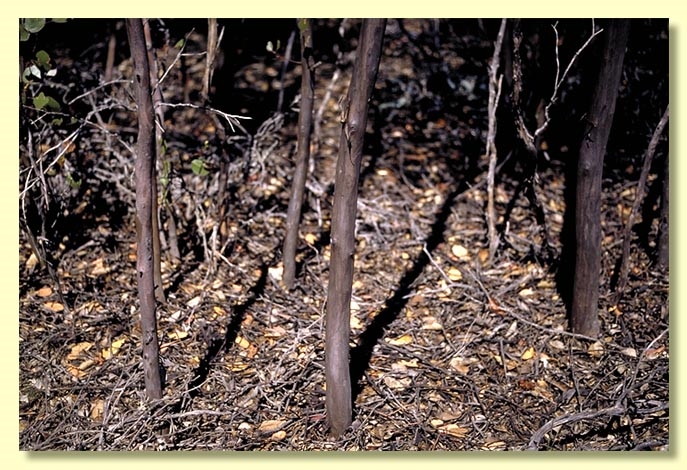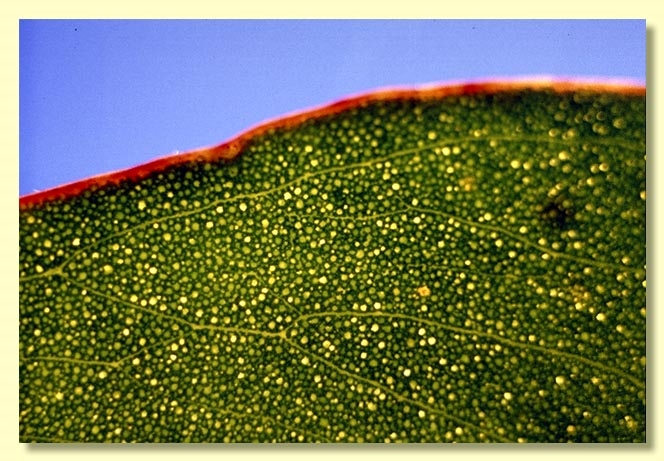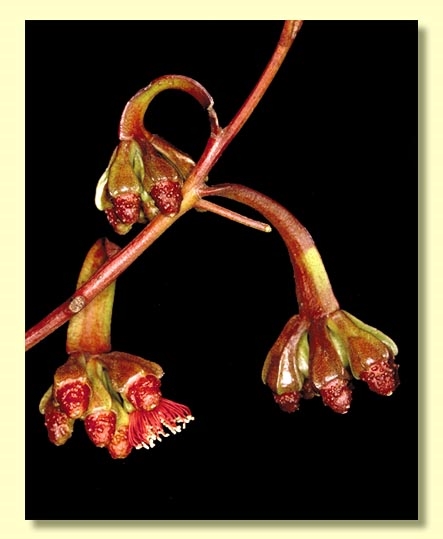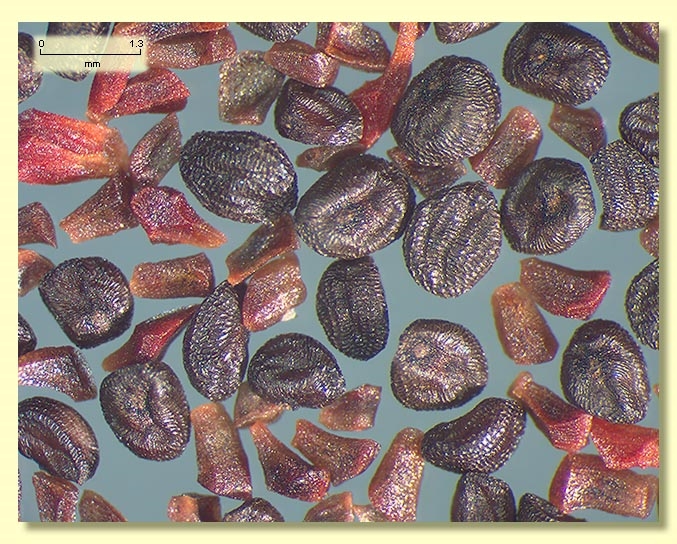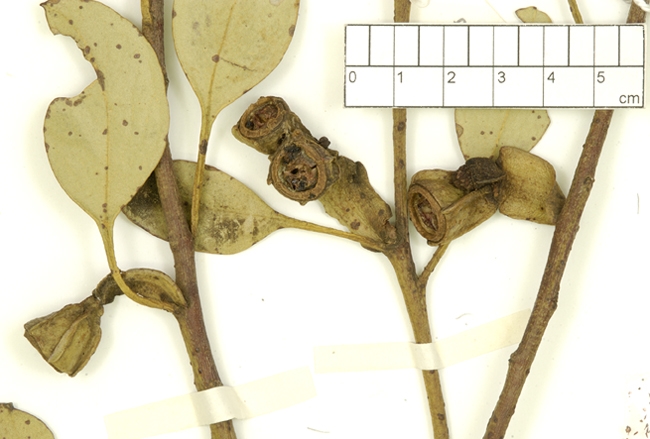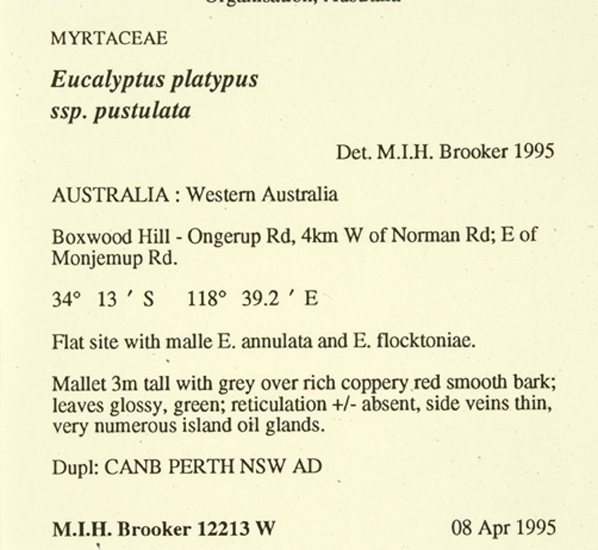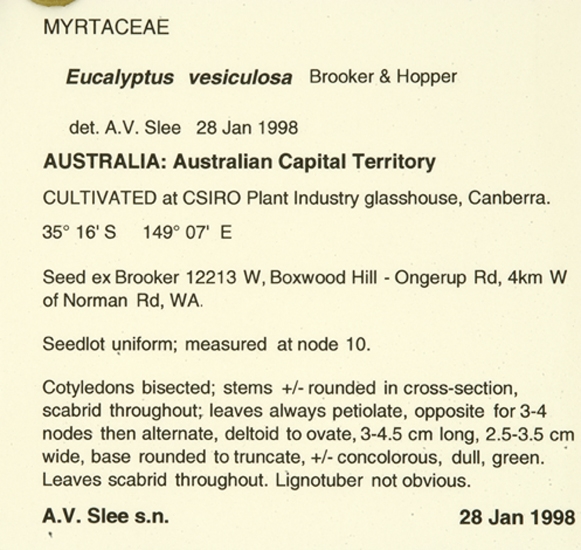Euclid - Online edition
Eucalyptus vesiculosa
Eucalyptus | Symphyomyrtus | Bisectae | Glandulosae | Clinatae
Bark smooth throughout, shiny, grey over rich red-brown.
Branchlets with large, clear oil glands in the pith.
Juvenile growth (coppice or field seedlings to 50 cm): not seen.
Adult leaves thick, held erect, alternate, petioles 2–3 cm long; blade elliptical to sub-orbicular or ovate, (4.2)5–7 cm long, 2.5–4 cm wide, base tapering to petiole, margin entire or distantly indented, apex rounded and apiculate or shallowly emarginate, concolorous, green, side-veins acute, intramarginal vein remote from margin, reticulation obscured by numerous round oil glands.
Inflorescence axillary unbranched, peduncles down-turned, strap-like, 1–4.5 cm long, buds (3)7, sessile to shortly pedicellate (pedicels 0–0.6 cm long). Mature buds more or less ovoid (1.5–1.7 cm long, 0.9–1 cm wide), egg-in-eggcup, i.e. the operculum narrower than the hypanthium at the join, scar present, operculum bluntly conical to rounded, grossly warty and pink to red contrasting with the green hypanthium with 4–6 prominent longitudinal ridges, stamens inflexed to varying degrees (rarely one or two outer stamens erect), anthers narrowly oblong, versatile, dorsifixed, dehiscing by longitudinal slits, style long and straight, stigma blunt, locules 5(6), the placentae each with 6 vertical rows of ovules. Flowers with red (rarely pale pink) filaments and cream anthers.
Fruit sessile to shortly pedicellate (pedicels 0–0.1 cm long), obconical, 1.5–1.8 cm long, 1.4–2 cm wide, disc level and finally descending, valves 5(6), at rim level or enclosed.
Seeds shiny blackish brown, 1–2 mm long, flattened-ovoid, dorsal surface shallowly reticulate, hilum ventral.
Cultivated seedlings (measured at node 10): cotyledons Y-shaped (bisected); stems rounded in cross-section, scabrid; leaves always petiolate, opposite for 3 or 4 nodes then alternate, ovate or deltoid, 3–4.5 cm long, 2.5–3.5 cm wide, dull, green, scabrid on surfaces and margins for at least 11 nodes. Scabridity due to bristle-glands.
Flowering has been recorded in September and October.
A marlock endemic to Western Australia, found in Corackerup Nature Reserve and at Reynolds Hill, north-east of Albany. Plants usually have a single erect stem bearing numerous side branches and generally a narrow form with a crown of green, glossy, broad elliptical-orbicular leaves not unlike E. platypus subsp. platypus with which it occurs.
In the classification of Brooker (2000) Eucalyptus vesiculosa belongs in Eucalyptus subgenus Symphyomyrtus section Bisectae subsection Glandulosae because the buds have an operculum scar, cotyledons are bisected and branchlets have oil glands in the pith. Within this very large group (some 80 species), E. vesiculosa is only closely related to two other species, E. cernua and probably E. vegrandis. Together these three species form series Clinatae characterised by having angled buds with a short operculum narrower than the hypanthium, inflexed stamens on a broad staminophore, leaves with many oil glands but not obscuring the main side-veins, and down-turned bud clusters.
Within series Clinatae, Eucalyptus vesiculosa is distinguished from E. cernua by having broader more rounded leaves and an extremely warty rounded operculum. The marlock habit (small mallet branching low) is also distinctive. E. vegrandis is always a mallee, has smaller buds that are not prominently angled and have a conical operculum, and the leaves are narrower and linear-lanceolate.
Eucalyptus vesiculosa is likely to be confused with the other marlock species, E. platypus and E. nutans, only from a distance because of the similarity in habit and adult leaves but, close up, E. vesiculosa can easily be identified by the buds with shorter very warty operculum and completely inflexed red staminal filaments with contrasting cream anthers. Eucalyptus nutans has very similar flowers to E. vesciculosa but in bud the stamens are erect like those of E. platypus, and the operculum lacks warts.
The stunning red flowers of this species make it well worth cultivating.


